#baleen whale
Text

Right whale
By: Unknown photographer
From: WWF Threatened Animals
1986
167 notes
·
View notes
Text
Wet Beast Wednesday: blue whale
It's the one-year anniversary of my Wet Beast Wednesday posts. My first post was on the smallest of all cetaceans, the vaquita. For the anniversary, I'm going to go to the other end of the spectrum and cover the largest of all cetaceans: the mighty blue whale. Join me as we explore the biggest of bois, the largest of lads, and the absolutest of units.

(Image: a blue whale at the surface of the ocean, seen from above. It is long, slender, and grey. The head is the widest point and takes up about a quarter of the body. The blowholes are positioned at the back of the head. Two flippers emerge from the body just behind the head. The tail fluke is very broad and pointed. End ID)
Blaenoptera musculus, the blue whale, is divided into four subspecies based on size and location. These are the northern blue whale (B. m. musculus), the north Indian ocean blue whale (B. m. indica), the antarctic blue whale (B. m. intermedia), and the pygmy blue whale (B. m. brevicauda). The northern and pygmy whales are further subdivided into population stocks based on what part of their range they live in. Blue whales are not only the largest cetaceans, they are the largest known animals to have ever existed. There are animals that can get longer, like the lion's mane jellyfish, but blue whales are the most massive animals. There are some extinct species that could potentially meet or exceed the blue whale in size, including some ichthyosaurs, whales, and sauropods, but all those species are known only from skeleton fragments so we can't get a fully accurate estimate of their size. Size varies depending on subspecies and population stock, but the longest group are the eastern north Pacific population, which can reach an average 24 m (79 ft). The antarctic subspecies is the heaviest, averaging 130 metric tons (290,000 lbs) for females. Females are larger than males. The pygmy subspecies is the smallest, though small is a relative term as they can still average 21.3 m (69.9 ft) and 99 metric tons (218,000 lbs). The longest scientifically measured individual was 30 m (98 ft), though there are unconfirmed reports of longer ones. The heaviest blue whale on record weighed 173 metric tons (381,400 lbs), though there are whales estimated to get up to 199 metric tons (438,720 lbs). Blue whales also have the largest hearts of any animal. One specimen measured in at 180 kg (400 lbs). The heart is about the size of a golf cart and 4 or 5 people could fit inside the chambers without having to squeeze. There's a commonly-quoted factoid that a person could swim through a blue whale's arteries without touching the sides. I wasn't able to find any exact measurements to confirm or refute this. I did find some sources saying that the blood vessels are highly elastic so its possible the factoids are talking about the arteries at their most stretched. Each heartbeat moves 220 liters of blood and the total blood volume is estimated at 5,300 liters. The heartbeat can be heard two miles away. I really just want to impress on you that these animals are fucking massive. A study on hydrodymanics suggested that a blue whale couldn't get longer than 33 meters (108 ft) before its metabolic and energy requirements would exceed the amount of food it could eat. Blue whales are verging on what is theoretically the maximum amount of big a whale can be.

(Image: an illustration comparing the size of a blue whale to other animals and showing their size. The whale is about as long as a line consisting of a polar bear, grizzly bear, human, asian elephant, giraffe, and great white shark. End ID. Source)
Blue whales are baleen whales, meaning that instead of teeth they have thick, keratinous plates called baleen attached to the upper jaw. When feeding, blue whales open their mouths and swim through clouds of krill. The mouth can open to 80 degrees and folds at the bottom let it expand to fit 220,000 liters of water at a time. The whale them closes its mouth and forces water out through the baleen. The baleen acts as a sieve, trapping krill in the mouth to be swallowed. Blue whales target patched of krill with the highest densities as their feeding style requires a minimum of 100 krill per cubic meter to offset the energy cost of feeding. Most mouthfuls provide 8,312 to 475,141 kilocalories of energy, more than enough to offset the cost of feeding. The current estimate for how much krill an adult needs in a day is 1,120 ± 359 kg (2,469 ± 791 lbs) and pregnant females need even more than that. Blue whales will dive in search of food, with the deepest confirmed depth being a pygmy blue whale that reached 506 m (1,660 ft). The deepest known dive from a non-pygmy blue whale was 315 m (1,033 ft). The longest recorded dive was 15.2 minutes and the estimated maximum dive duration is 31.2 minutes. During dives, a blue whale's heartbeat slows to 2 beats per minute, the slowest of any known animal. The elastic aorta seems to take over a lot of the heart's pumping job during this time. Blue whales are streamlined and similar in appearance to the relates sei whales and fin whales. Blue and fin whales are capable of hybridizing and producing fertile offspring. 3.5% of the blue whale genome comes from hybridization with fin whales. While blue whales can produce hybrid offspring with fin whales, the reverse is not true and the gene flow from fin to blue is unidirectional. It appears that all hybrids are the result of a fin father and a blue mother. Interestingly, blue whales do not appear to be capable of hybridizing with the more closely related sei whales. There are unconfirmed reports of blue whale and humpback whale hybrids. And because someone was going to bring it up if I didn't, the blue whale's penis is the largest of any animal at 3 m (9.8 ft) long and 30 cm (12 in) wide and they can release an estimated 17 liters of semen at a time. I know someone out there desperately wanted to know that and to that person I say you're whalecum.

(Image: a blue whale feeding at the surface of the ocean on its side, seen from above. The mouth is open with the troat and lower mouth inflated. It is swimming into a patch of krill, visible as yellowish coloration in the water. End id)
Blue whales can be found worldwide, though they typically prefer colder water and do not enter the Arctic ocean. They are usually solitary or travel in pairs, but can gather in groups up to 50 strong when food is abundant. Many are migratory, feeding in cold water during the summer and moving toward the equator in winter. They can follow complex migratory patterns that have to be memorized. There are multiple different strategies employed by different populations regarding who migrates when and some populations don't migrate at all. Their vocalizations are used for long-distance and short-range communication and scientists have classified multiple different types of sounds produced. Different populations of whales have different patterns of vocalizations which may be akin to languages or dialects. Blue whale sounds are some of the loudest and lowest frequency produced by any animal and most are too low-frequency to be audible to humans. Mating season happens in winter. Males use vocalizations to attract females, who they then court through special noises, blowing bubbles, inflating their mouths, chasing, and slapping the water with their flippers. Males compete with each other for the chance to mate. Once a female chooses a male, they will mate and then separate. Gestation takes 10 to 12 months. Newborn blue whales are the largest babies in the animal kingdom at 6-7 m (20-23 ft) and 2-3 metric tons (4409 to 6614 lbs). Mother produce between 110 and 320 kg (240 - 710 lbs) of milk daily. Claves are weaned between 6 and 8 months once they hit 16 m (53 ft) and have gained about 17,000 kg (37,500 lbs). Females typically mate every 2 to 3 years. Blue whale become sexually mature at 8-10 years old and can live over 90 years, with the oldest on record being 110 years old. Their age can be determined by earwax, which is laid down in rings like trees.

(Image: a mother blue whale (background) and calf (foreground). The baby is already very large and is a lighter grey than the mother. The baby is seen from the sied while the mother is rotates to show her underside. End ID)
All blue whale subspecies are classified as endangered by the IUCN, with the antarctic subspecies being critically endangered. Blue whales were heavily impacted during whaling, with their population dropping to the point of near-extinction. Since the end of whaling, populations have risen to an estimated 10,000 to 25,000 as of the end of 2023. This is still smaller than their pre-whaling population, but they have recovered quite a bit. The current largest threats to blue whales are climate change, collisions with ships, and human created noise. The effects of anthropogenic noise from shipping lanes on aquatic animals is still poorly understood, though it seems to greatly irritate and even harm whales, forcing them to change their migratory routes and avoid shipping lanes. Interestingly, as the population has increased scientists have noted changes in courtship behavior and vocalization tone. It is hypothesizes that the increasing population is resulting in greater competitive pressure between males for the right to mate.

(Image: a blue whale seen from the side. Its head is toward the camera. The lower jaw as larger and thicker than the upper jaw. The animal is streamlined. The eye is just behind the mouth and small. Further back is a paddle-shaped flipper. End ID)
#wet beast wednesday#blue whale#whale#whales#cetaceans#cetacean#marine mammals#baleen whale#marine biology#biology#zoology#ecology#animal facts#informative#image described#science#absolute unit#big#anniversary
65 notes
·
View notes
Text

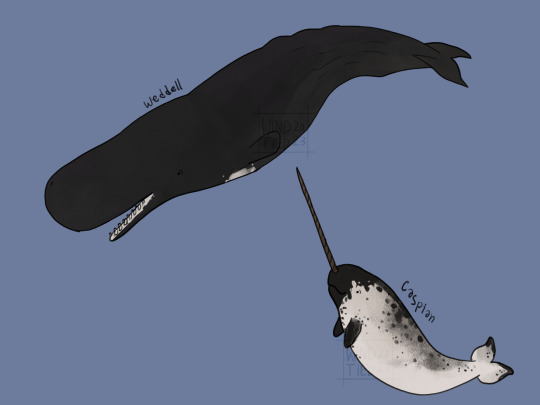


some cetacean ocs :)
#oc#art#cetacea#beaked whale#dolphin#sperm whale#baleen whale#fin whale#humpback whale#narwhal#toothed whale
86 notes
·
View notes
Text




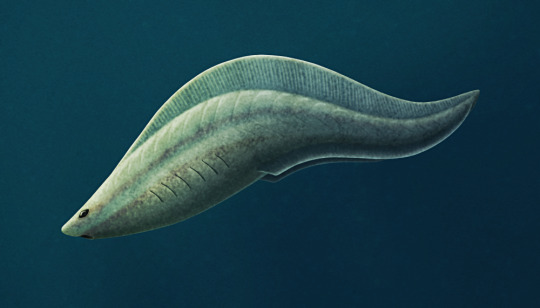
I haven't posted any PBS Eons commissions here for quite a while, so let's catch up a bit of the backlog:
• The Cretaceous mammals Repenomamus robustus and Repenomamus giganticus, from "When Mammals Only Went Out At Night"
https://www.youtube.com/watch?v=JqZONKXWPfw
• A carcass of the whale Borealodon, from "How Ancient Whales May Have Changed the Deep Ocean"
https://www.youtube.com/watch?v=1vb00-gcdtA
• And the early vertebrates Haikouichthys and Myllokunmingia, from "Why Sour May Be The Oldest Taste"
https://www.youtube.com/watch?v=XXgd_cNZSvk
———
NixIllustration.com | Tumblr | Twitter | Patreon
#science illustration#paleontology#paleoart#palaeoblr#pbs eons#repenomamus#gobiconodontidae#eutriconodonta#mammal#borealodon#mysticeti#baleen whale#cetacean#whale#marine mammal#haikouichthys#myllokunmingia#vertebrate#art#dead animal cw#carcass
327 notes
·
View notes
Text
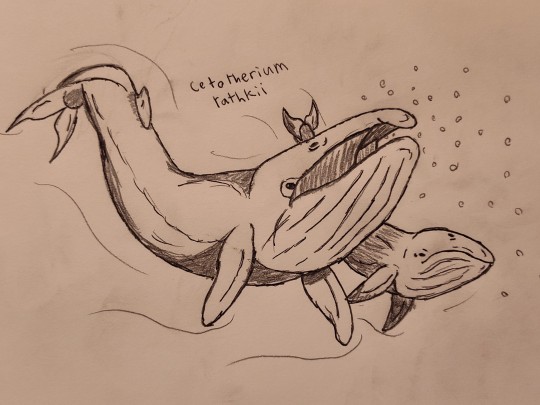
Cetotherium (whale beast) was a relatively small baleen whale that lived between 23 and 2 million years ago. These whales have been estimated to measure up to 6.8 feet, and fossil evidence suggests it was often preyed on by the iconic shark megalodon as well as the raptorial toothed whale Livyatan. Cetotherium had no teeth and used its baleen to bulk feed on small animals like plankton and krill.
#cetotherium#paleoart#paleontology#evolution#baleen whale#whales#whale evolution#whale#cetacean#cetaceans#miocene#pliocene#paleogene
28 notes
·
View notes
Text
The Hot Wife and I went to the Calvert Marine Museum for First Fossil Friday to have a paleontologist take a look at a whale vertebra my Mom found at Calvert Cliffs in the 50s and 3 things I at the Cliffs and at Flag Pond found to identify them.
The fossils are from the Miocene. They are: a vertebra from an adult baleen whale, a scapula from a sea turtle, a tooth from either an Otodus chubutensis or Otodus megladon but he couldn’t tell because of how the tooth is broken - which is similar to other teeth he’s seen that were modified by Native Americans for use as a spear point!!!! The final fossil is the inside of a geoduck and part of its shell.
We also stopped by to see the river otters (the Hot Wife’s fav part of the museum) who put on quite a show for her, swimming up to look at her and swimming away.
Then we hit the gift shop and I found the best fake teeth ever!
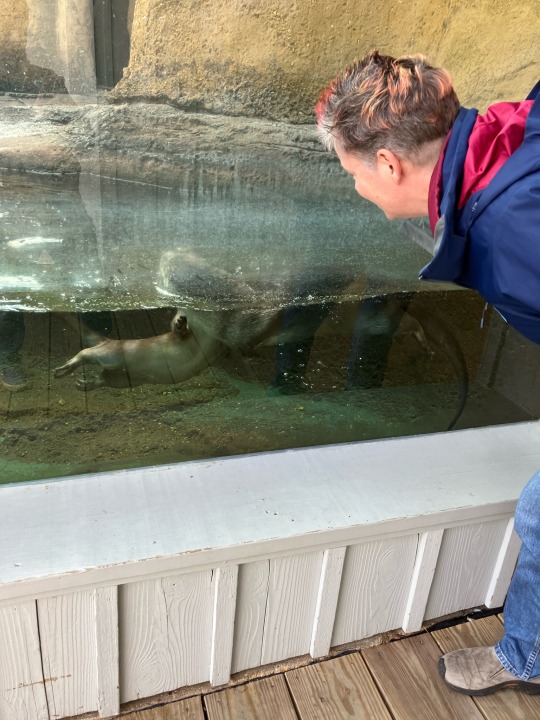
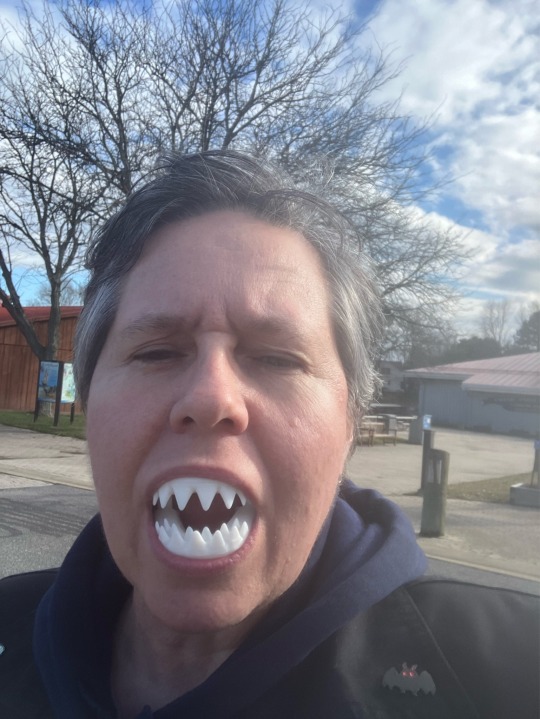




#butch#dyke#wlw#sogay#lesbian#queer#wives#this is love#lgbtq#fossils#megladon#sharkteeth#whale#baleen whale#Calvert formation#Miocene#paleontology#Calvert Marine Museum#Calvert Cliffs#Flag Pond#Maryland
28 notes
·
View notes
Text
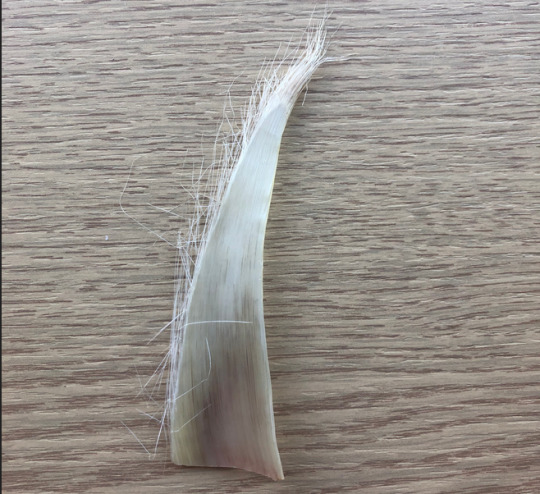
whale baleen moment! From a minke whale that had been beached ( :( ) and died ( :(((( ) (baleen collected by a marine mammologist, cleaned, and given to me)
Very small baleen, only about 10cm or so. baleen can be Metres Long though and that is so weird and cool!
Some fun facts about baleen:
1) made of keratin like human hair and rhino horns
2) grows continuously in fairly solid “sheets” which gain the feathery bristles (shown better right below) by grinding against other sheets of baleen (much like rat teeth, this grinding makes sure the baleen doesn’t get too big for the whale’s mouth!)

3) as the baleen grows and wears down continuously, a piece of baleen will have a temporal arrangement of molecules, in terms of when the whale consumed the molecule (and assimilated it into baleen growth)
that means a piece of baleen can be analysed to reveal the whale’s diet and where it has been living (though the assimilation rates of isotopes into the whale needs to be considered here) -- there have been studies into using this to get a better idea of how much pollution a whale has been exposed to so we can keep better track of their health!
ah... remember how I said this was small baleen? Well, the size of baleen can help you figure out how a whale feeds. there are three main types of feeding in baleen whales: lunge, skim, and sediment. Lunge feeding is when the whale rockets forward, opens its mouth, and takes a big gulp of water. Skim feeding is when the whale swims with its mouth open. Sediment/bottom feeding is when the baleen is used to comb thru the sea floor for critters. Long baleen with a high surface area is useful for skim feeding since it means you can have your mouth nice and wide to catch more things... but long baleen wouldn’t be great for digging around in the mud, so sediment feeders have short and robust baleen.
And this size difference can be HUGE! for context, here’s my stylishly-censored hand next to a skim feeder’s baleen. The little one next to it is closer to the minke whale baleen in the first and second image (though a bit bigger)... that’s a sediment feeder’s baleen !
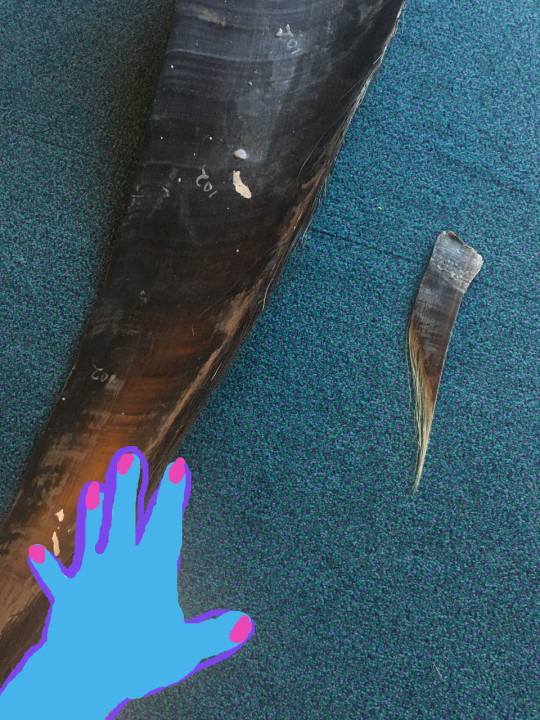
more about baleen whale feeding types here, because lunge feeding is fcked up lmao
#whale#baleen whale#cetaceans#marine mammals#marine biology#zoology#mammals#vertebrates#science#biology#sciblr#bioblr#baleen#miaow
86 notes
·
View notes
Photo


Bowhead Whale (Balaena mysticetus)
Family: Right Whale Family (Balaenidae)
IUCN Conservation Status: Least Concern
Named for its extremely large, bow-shaped head (which can be used to smash through thin sea ice when surfacing to breathe), the Bowhead Whale can grow to be 15-18 meters (50-60ft) long, may weigh over 54,500 kg (120,000lbs) and is believed to have the potential to live for over 200 years (quite possibly the longest lifespan of any mammal.) Native to arctic and sub-arctic oceans, it feeds on plankton and other small invertebrates which it filters from the water using the comb-like baleen plates in its mouth; its extremely long baleen plates (around 4 meters/13ft in length, longer than those of any other whale) and enormous head (which makes up around 1/3rd of its total body length and features the largest mouth of any animal, opening to be around 3.7 meters/12ft high and 2.4 meters/8ft wide) make it one of the most efficient filter-feeders on earth, allowing an adult Bowhead Whale to consume around 2 tonnes of prey each day. In comparison to other whales Bowhead Whales are not particularly social and typically live alone or in small groups of 3-6 individuals, although during migration they may gather in larger numbers, and as they are not particularly aggressive towards other members of their species it is not unusual for several unassociated individuals to gather together in particularly plankton-rich areas when feeding. Bowhead Whales migrate south to relatively warm subarctic waters during the arctic winter to avoid becoming trapped beneath sea-ice that is too thick for them to break through, and while they may mate at any time of year they typically give birth while migrating back to the arctic in the spring, producing a single calf every 3-4 years after a gestation period of 13-14 months (with calves already being around 4 meters/13ft long and weighing over 900kg/2000lbs at birth.) The enormous size of this species means that it has only one natural predator (the Orca), but historically humans have hunted Bowheads extensively for their meat, bones, blubber and baleen. Commercial whaling once brought Bowhead Whales to the brink of extinction, but throughout the 1970s the practice of hunting this species was near-universally outlawed (with the only exceptions being made for two indigenous communities in Siberia and Alaska who hunt members of this species for subsistence on such a small scale that they do not have a significant negative impact on the species’ overall population.) As of the time of writing this, the IUCN believes that the numbers of several local populations of Bowhead Whales have stabilized and begun to recover from the damage done by commercial whaling, with the species’ overall global population numbers actively increasing.
--------------------------------------------------------------------------
Animal Advent Calendar - Day 23
Image Source: https://www.inaturalist.org/taxa/74103-Balaena-mysticetus
#December 23rd#Bowhead Whale#Whale#Whales#mammal#mammals#zoolog#biology#mammalogy#marine biology#marine animals#marine wildlife#arctic wildlife#wildlife#marine mammal#baleen whale#baleen whales#Bowhead whales
197 notes
·
View notes
Photo
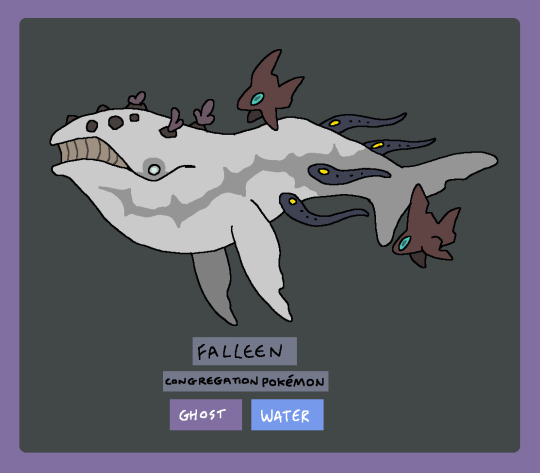
#130 - Falleen
#fakemon#pokemon#ghost type#water type#rorqual#baleen whale#whale#whale fall#parasite#deep sea#lamprey#chimaera#leviathan
830 notes
·
View notes
Text

Types of whales
(Baleen Whale)
1. Humpback Whale
2. Blue Whale
3. Dwarf Minke Whale
(Toothed Whales)
1. Killer Whale
2. beluga whale
3. narwhal whale
#my art#furry art#digital aritst#digital art#whale#humpback whale#Blue Whale#Dwarf Minke Whale#killer whale#beluga whale#narwhal whale#baleen whale#Toothed Whales
19 notes
·
View notes
Text

Humpback whale
22 notes
·
View notes
Text

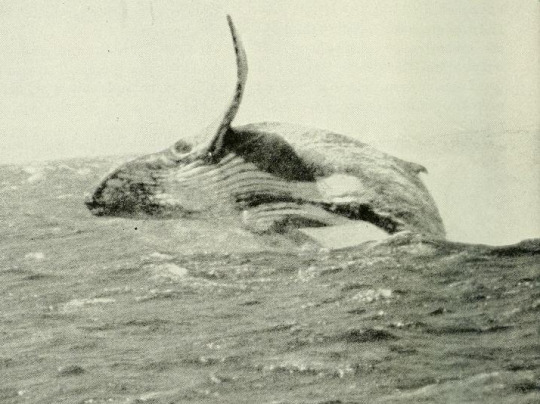
A playing humpback whale
By: Alfred C. Glassell, Jr.
From: Natural History Magazine
1953
#humpback whale#baleen whale#whale#mammal#1953#1950s#Alfred C. Glassell Jr.#Natural History Magazine
344 notes
·
View notes
Text

via sleepless dreams
#marine life#cetaceans#cetacean photography#cetacean#humpback#humpback whale#whale photography#baleen whale#cetacean enrichment
20 notes
·
View notes
Text
baleen whale my beloved
4 notes
·
View notes
Text
It Came From The Wastebasket #11: A Cetothere Change
Cetotheres were a group of small baleen whales, one of three major lineages of these cetaceans alongside the rorquals and the right whales. They first appeared in the fossil record in the mid-Miocene, about 14 million years ago (but are estimated to have actually originated 10-15 million years earlier), and disappeared during the Pleistocene about 2 million years ago.
First recognized in the mid-19th century, for a long time the cetotheres were used as a wastebasket for all fossil baleen whales that didn't clearly fit into any modern whale families. By the start of the 21st century nearly 30 different genera representing numerous different species were all lumped into the group – and the genus Cetotherium was another wastebasket in itself with at least 12 assigned species, many of which were based on fragmentary or dubious remains.
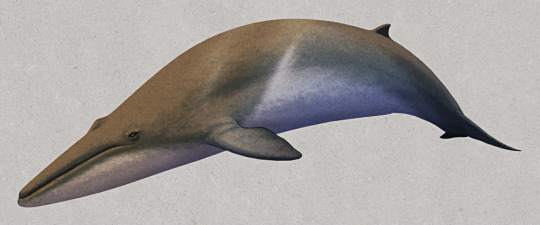
Ciuciulea davidi
This was finally cleaned up in the 2000s, when a revision of the cetotheres cut the group down to just 6 genera. Since then a handful of additional new genera and species have been named, and while a few polyphyletic Cetotherium species may still need tidying up the cetotheres have overall gone from being a total taxonomic mess to actually being one of the best studied groups of fossil baleen whales.
Their exact evolutionary relationships with each other are still in flux, but the most surprising discovery from the improved understanding of these ancient whales is that they might not be extinct after all.

A study in the early 2010s suggested that the pygmy right whale may actually be a living cetothere. This classification was initially controversial, but further discoveries of fossil relatives of this enigmatic modern whale and comparisons of their distinctive inner ear anatomy have provided stronger evidence for an evolutionary link.
At this point it seems fairly likely that the pygmy right whale really is either the last surviving representative of the cetothere lineage, or at least is a very close evolutionary "cousin" (a "cetotherioid") closer related to them than to any other modern baleen whales.
———
Nix Illustration | Tumblr | Twitter | Patreon
#it came from the wastebasket#wastebasket taxon#taxonomy#ciuciulea#cetothere#cetotheriidae#mysticeti#baleen whale#cetacean#artiodactyla#ungulate#mammal#paleontology#art#science illustration#paleoart#palaeoblr
190 notes
·
View notes
Text
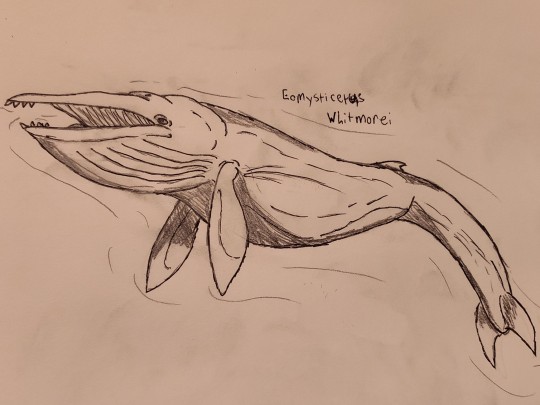
Eomysticetus (dawn baleen whale) was a mysticete that lived around 25 million years ago, and was discovered in South Carolina. Much like Aetiocetus, this whale had both teeth and baleen, although its baleen were much more prominent, and its teeth were likely vestigial. It most likely primarily utilized filter feeding like modern baleen whales, gulping loads of water and filtering microorganisms from the water. Bulk feeding in this way would prove to be a useful adaptation and would allow these creatures to get absolutely massive.
#eomysticetus#paleoart#paleontology#evolution#baleen whale#whales#whale evolution#whale#cetacean#cetaceans#oligocene#paleogene
19 notes
·
View notes